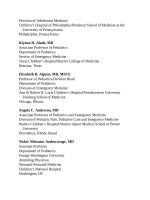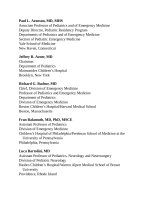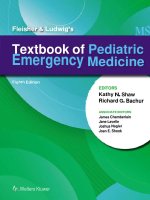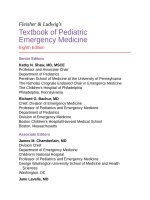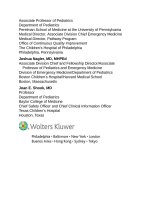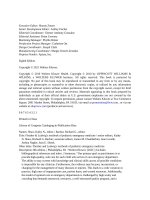Pediatric emergency medicine trisk 1811 1811
Bạn đang xem bản rút gọn của tài liệu. Xem và tải ngay bản đầy đủ của tài liệu tại đây (75.23 KB, 1 trang )
Other vascular nodules, including kaposiform hemangioendotheliomas and
sarcomas, should be considered when vascular papules or nodules feel firm or do
not follow the natural history of infantile or congenital hemangiomas. Acquired
lesions include Spitz nevi and pyogenic granulomas.
Spitz nevus. Spitz nevi appear suddenly between 2 and 13 years of age.
Preferred sites of growth include the cheek, shoulder, and upper extremities ( Fig.
88.7 ). The lesion has a pink to red surface because of numerous dilated blood
vessels. Pressure produces blanching of this pink to red color. The lesions can
reach 1.5 cm in diameter but are completely benign. Pigmented Spitz nevi,
another variant of Spitz nevi, often appear black in the skin rather than pink-red,
and their appearance is often worrisome for malignant melanoma. Because the
histologic appearance of these lesions can be confused easily with a malignant
melanoma, an experienced histopathologist should interpret the findings. Most
clinicians still recommend that Spitz nevi be removed surgically.
Pyogenic granulomas. Pyogenic granulomas ( Fig. 88.8 ) are bright red to
reddish-brown or blue-black pedunculated, vascular papules/nodules ranging
from 0.5 to 2 cm in size that develop rapidly at the site of an injury, such as a cut,
scratch, insect bite, or burn. Pyogenic granulomas occur commonly in children
and young adults, usually on the fingers, face, hands, and forearms.
They bleed easily. Generally, they are asymptomatic. Because spontaneous
disappearance is rare, patients should be referred for definitive treatment,
typically with curettage, excision, electrosurgery, cryosurgery, laser surgery, or
some combination of these various modalities.




